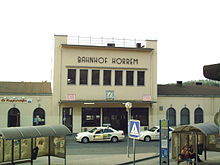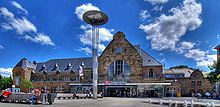- Cologne–Aachen high-speed railway
-
Cologne–Aachen high-speed railway Course of the Cologne-Aachen upgraded lineRoute number: 480 Line length: 70 Gauge: 1435 Voltage: 15 kV 16.7 Hz AC Maximum speed: 250 km/h Legend


HSL to Frankfurt, Düsseldorf S 6S 11S 12S 13 


Hohenzollernbrücke (from Köln Messe/Deutz) 


Cologne Stadtbahn 


0.0 Köln Hbf 


0.8 Köln Hansaring, terminus of S 13 


0.8 Köln Hansaring Wendeanlage 


1.4 To Köln Bbf 


West Rhine Railway to Köln West 


West Lower Rhine Railway to Köln-Nippes S 6S 11 


2.0 Köln-Nippes–Köln West freight line 


Herkulesstraße junction from Köln West 


S-Bahn Flying junction 





3.2 Cologne Stadtbahn 


3.7 Köln-Ehrenfeld 


Köln-Ehrenfeld freight station 


To HGK freight railway 


Cologne–Frechen line (HGK) 


5.9 Köln-Müngersdorf Technologiepark 


5.9 Müngersdorf Technologiepark crossover 


7.2 Köln-Ehrenfeld, freight station west 


Line to Mönchengladbach 


9.0 Old Lövenich station 


9.7 Lövenich S-Bahn 


11.1 Köln-Weiden West 


13.8 Frechen-Königsdorf 


15.0 Start of cutting (formerly Königsdorf Tunnel) 


16.5 North-South Railway (RWE Power) 


16.6 Start of cutting (formerly Königsdorf Tunnel) 


18.5 Erft Railway to Neuss 


18.7 Horrem 


Former Erft Railway to Mödrath 


Erft 


21.4 Sindorf crossover (start single line S-Bahn) 


21.4 Sindorf 


22.4 Sindorf 


22.6 Sindorf siding 


26.0 Dorsfeld (overtaking loop) 


27.8 Buir crossover (start double line S-Bahn) 


30.3 Buir 


35.0 Merzenich 


Former Erft Railway from Neuss 


35.7 Merzenich crossover (start single line S-Bahn) 


37.3 Düren Vorbf 


39.0 Börde Railway from Euskirchen 


39.1 Line from Jülich 


39.2 Düren, terminus of S 12 





39.8 Line to Heimbach 
Rur (Düren triangular truss bridge) 
42.2 Hubertushof crossover, military siding 
Derichsweiler (former overtaking loop) 
48.9 Langerwehe 


(Connecting to Inde Valley Railway since 2009) 


Uhlhaus Tunnel 285 m 


Inde Valley Railway from Jülich 


Eschweiler-Weisweiler (formerly Weisweiler) 


Inde Valley Railway 
54.1 Nothberg (Schließung im Dez. 2009) 
Jägerspfad (last level crossing) 
56.9 Eschweiler Hbf 
57.0 Ichenberger Tunnel (95 m) 
57.9 Three arch bridge (Inde) 
58.0 Inde Valley Railway 
Inde Valley Railway 
59.8 Stolberg (Rheinl) freight yard 
60.3 Venn Railway to Stolberg Altstadt 
60.3 Stolberg (Rheinl) Hbf 
Connecting curve to Stolberg Altstadt 
Line to Herzogenrath 
Herzogenrath–Stolberg 
Nirmer Tunnel 125 m 
Eilendorf Tunnel 357 m 
64.9 Eilendorf 


Line from Aachen Nord 


Aachen-Rothe Erde Wertz (siding) 



67.4 Aachen Rothe Erde freight station 
68.2 Aachen-Rothe Erde 
Burtscheid Viaduct 277 m 
70.2 Aachen Hbf 
to Mönchengladbach 
72.9 Aachen Süd 
Busch Tunnel 691 m 
77.0 German/Belgian border 
Old line and HSL 3 to Liège The Cologne–Aachen high-speed line is the German part of the Trans-European transport networks project high-speed line Paris–Brussels–Cologne. It is not a newly built railway line, but a project to upgrade the existing railway line which was opened in 1841 by the Rhenish Railway Company. When it was continued into Belgium in 1843, it became the world's first international railway line.[citation needed]
The line inside Germany has a length of about 70 kilometres (43 mi). The first 40 km (25 mi) from Cologne to Düren have been rebuilt. Since 2002 the line allows for speeds up to 250 km/h (160 mph). Separate tracks have been built parallel to the high-speed tracks for local S-Bahn traffic. The remaining line from Düren to Aachen allows speeds up to 160 km/h (99 mph) with some slower sections. Upgrades of Düren–Aachen are planned for the near future. In Belgium, the high-speed line is continued as HSL 3.
Regional Express services on the line are RE 1 (NRW-Express) and RE 9 (Rhein-Sieg-Express) with push-pull trains with five double-decker carriages. Long-distance trains are operated by Thalys between Paris and Cologne (six pairs of trains each day), three pairs of ICE 3M trains daily between Frankfurt and Brussels Monday to Saturday and a morning ICE 2 between Aachen and Berlin.
Contents
History
On 21 August 1837 the Rhenish Railway Company received a concession from the Prussian government to build the railway line from Cologne via Düren and Aachen to the Belgian border, a distance of 86 kilometres. The first seven kilometres of track from Cologne to Müngersdorf was opened in 1839. Two further sections to Lövenich and from Düren to Aachen were completed in 1840 and 1841. This includes the 1,632 m long Königsdorf Tunnel, which was had its roof removed in 1954. The resulting cutting was widened in 2000 to accommodate four tracks. The last section to the Belgian border at Herbesthal was opened to traffic on 15 October 1843. There was a grade of 1:38 between Aachen and Ronheide (the Ronheide ramp). Until 1855, cable-haulage powered by a stationary steam engine assisted trains up the slope. The line was the first line linking a German railway line with a country outside the German Confederation.
The opening of the line created further connections as the already well-developed Belgian network had two connections with northern France, but the routes to Paris was only finished in 1846, on 16 June from Valenciennes, and on 20 June 1846 from Lille.
Route
 Eschweiler station
Eschweiler station
The upgrading of the line was first mentioned in the first Federal Transport Infrastructure Plan of 1973.[1] It was also included in the updated plan of 1985.[2]
Work began with a symbolic driving of a pile on 22 October 1997. The federal and state governments agreed to spend 1.1 billion D-Marks was spent on building two new tracks between Cologne and Düren for high-speed trains and develop the existing line for S-Bahn services.[3] Since 14 December 2003, trains have been able to operate on this section at up to 250 km/h. Parts of the parallel S-Bahn line are only single track. All stations between Cologne and Düren were rebuilt as S-Bahn stations. Under a second stage, the section between Düren and Langerwehe is to be upgraded for speeds up to 200 km/h. The section from Eschweiler to Aachen, which currently has a speed limit of 110 km/h to 140 km/h, would be cleared for 160 km/h. The section from Aachen to Aachen-Süd (on the border with Belgium) would also be cleared for 160 km/h operations.[4]
The Busch Tunnel at the border is the oldest railway tunnel in Germany that is still in use with some parts dating back to 1838.[citation needed] When the line was electrified, the limited space inside the tunnel meant that the line had to be rebuilt as a single track. Because of the tunnel's poor conditions, speeds had to be limited to 40 km/h (25 mph). A second parallel single-line tunnel was built in between 2004 and 2007. The old tunnel is currently being rebuilt with a new lining and will be returned to service as a single track, with increased clearance.
References
- ^ Block, Rüdiger (1991). "Auf neuen Wegen. Die Neubaustrecken der Deutschen Bundesbahn (The new lines of the German Federal Railways)" (in German). Eisenbahn-Kurier (21): 30–35.
- ^ Block, Rüdiger (1991). "ICE-Rennbahn: Die Neubaustrecken (ICE Racetrack: The new lines)" (in German). Eisenbahn-Kurier (21): 36–45.
- ^ "Gemeinschaftsprojekt Köln – Aachen (Cologne - Aachen community project)". Eisenbahn-Revue International (12): 551. 1997.
- ^ "Projekt Nr. 15 - ABS Köln - Aachen - Grenze D/B" (in German) (PDF). Federal Ministry of Transport, Construction and Urban Affairs. http://www.bmvbs.de/static/Schiene2006/L15.pdf. Retrieved 10 march 2010.
See also
External links
- Trainspotting Bükkes: Cologne - Aachen - Brussels
- "Upgraded Line (Ausbaustrecke) Cologne-Düren (ABS 4)". http://www-users.rwth-aachen.de/christoph.schmitz2/strecke/strecke_e.html. Retrieved 25 August 2011.
- "Cologne–Aachen (border), long-distance services" (in German). NRW Rail Archive. André Joost. http://nrwbahnarchiv.bplaced.net/strecken/2600.htm. Retrieved 25 August 2011.
- "Köln Hansaring–Düren, S-Bahn" (in German). NRW Rail Archive. André Joost. http://nrwbahnarchiv.bplaced.net/strecken/2622.htm. Retrieved 25 August 2011.
- "Photographs of tunnel portals" (in German). Lothar Brill. http://www.eisenbahn-tunnelportale.de/lb/inhalt/tunnelportale/2600.html. Retrieved 25 August 2011.
- Kursbuchstrecke 480 "Aachen - Köln" (in German). http://vonderruhren.de/aachenbahn/seiten/kbs480.php Kursbuchstrecke 480. Retrieved 25 August 2011.
High-speed railway lines East Asia JapanChinaBeijing-Shanghai · Qinhuangdao–Shenyang · Hefei–Nanjing · Beijing–Tianjin · Qingdao–Jinan · Shijiazhuang–Taiyuan · Hefei–Wuhan · Ningbo–Taizhou–Wenzhou · Wenzhou–Fuzhou · Wuhan–Guangzhou · Zhengzhou–Xi'an · Fuzhou–Xiamen · Chengdu–Dujiangyan · Shanghai–Nanjing · Nanchang–Jiujiang · Shanghai–Hangzhou · Hainan Eastern Ring · Changchun–JilinSouth KoreaGyeongbu HSRTaiwanEurope BelgiumFranceLGV Sud-Est · LGV Est · LGV Atlantique · LGV Rhône-Alpes · LGV Nord · LGV Interconnexion Est · LGV Méditerranée · Perpignan-FigueresGermanyCologne–Düren · Cologne–Frankfurt · Hanover–Würzburg · Mannheim–Stuttgart · Rastatt–Offenburg · Wolfsburg–Berlin · Nuremberg–IngolstadtItalyNetherlandsNorwaySpainMadrid–Barcelona · Madrid–Sevilla · Córdoba–Malaga · Madrid–Valladolid · Madrid–Toledo · Figueres–Perpignan · Madrid–Valencia · Motilla–AlbaceteTurkeySincan–Eskişehir · Polatlı–KonyaUnited KingdomNorth America United StatesCategories:- High-speed railway lines in Germany
- Transport in Cologne
- Aachen
- Railway lines in North Rhine-Westphalia
Wikimedia Foundation. 2010.





